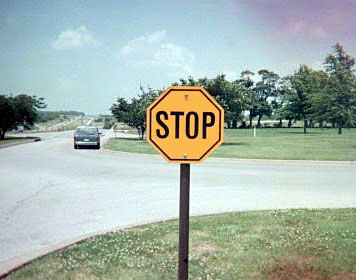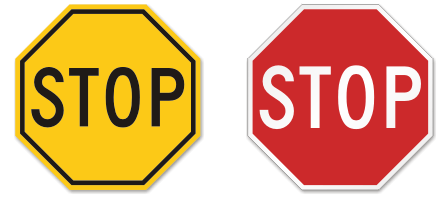
Signs Must Work with All Vehicle Types

Yes, at one time there were yellow stop signs. This all changed, however, in the 1950’s.
It is universally known that the stop sign, the most famous traffic sign in the world, is red. It is red, signifying danger and violence, and warns drivers to make a brief and momentary stop, and then proceed when the way is clear.
However, a little over fifty years ago, this was not so. The first stop sign, originating from 1915, was white with black lettering, and was not even octagonal. In 1924 the prominent color was yellow with black writing, and was somewhat smaller than the modern stop sign. A report by the an organization that preceded AASHTO advocated a yellow background is best for danger and caution signs – in that yellow and black offer good contrast. At night, red and white was seen as not offering sufficient visibility.

Studies have shown that humans have learned to differentiate colors, and they act differently in response to various hues. We find it appropriate to regard green as the opposite of red, and use red and green to symbolize minus and plus, respectively. Therefore, if red is consistently regarded as the danger or "stop" color, green is thought of as the safe-to-go color. Yellow, however, is the intermediate color. The "ordering of the colors green-yellow-red is the same as the ordering of the instructions go-caution-stop"*. This is one of the reasons the black-on-yellow stop sign was altered; yellow symbolizes caution-and-slow down, not danger-and-stop.
In 1806, the first red signal lamp was used in an English lighthouse because was discovered that red was the most translucent color of stained glass. Ever since then, red lamps have been used in many lighthouses, ships, railroads, and in 1914, in street signals. It is unclear whether the origins of red traffic signs originally come from this specific lighthouse in England, or the violent nature of the color, but it is probably a combination of both.
However, by 1923, some engineers discovered that those with red-green color blindness have difficulty recognizing stop signs and red traffic lights under certain conditions. In bright sunlight, red looks dim and faint in comparison to the trees and sky in the background. This can cause problems for drivers that are color blind, a disease that affects 5% of men and 1% of women. Changing the sign to another color, such as blue, would cause much confusion and chaos, and also would not be as noticeable on the road.
Nevertheless, there are several visual cues other than color that can identify a stop sign. The unique octagonal shape allows drivers to recognize the sign ahead of time, as well as informs drivers facing the back of the sign that the oncoming traffic has a stop sign. The white letters sign heading displaying the word "STOP" also inform drivers of the sign ahead.
The stop sign is one of the most important signs in the road, and it is imperative that it is visible to everyone. For this reason, the color red was chosen for the sign because of its high contrast visibility. However, for many color blind and even non-color blind drivers, shape can help even more than color.
* H. Austin Aikins, "Confusing Traffic Signals" Jstor, Apr. 1925: 442-444.
- Katy Brewster











 Signs Must Work with All Vehicle Types
Signs Must Work with All Vehicle Types

